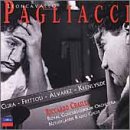Chailly/Royal Concertgebouw
Decca 467-086-2 (73’05)






Buy it | Acheter - le @ amazon.com
Buy it | Acheter - le @ archambault.ca
Leoncavallo: Pagliacci
Chailly/Royal Concertgebouw
Decca 467-086-2 (73’05)





Buy it | Acheter - le @ amazon.com
Buy it | Acheter - le @ archambault.ca
There are already
many superb recordings of Leoncavallo’s Pagliacci*available. This new
recording, made at the Concertgebouw, Amsterdam, in Sept. 1999, is one of the
best in decades, but overall belongs to the second rank of Pagliacci
CD recordings. Argentine tenor
José Cura (Canio) is the bankable star of this opera, its commercial and artistic
raison d’être. In the history of opera, there have been singers and actors and,
more rarely, singing actors. Pure singers like Tucker, Bjoerling, and many sopranos,
were useless actors. Recordings convey the better part of their gifts. Cura
must be counted among the singing actors like Jon Vickers and Bryn Terfel, who
have to be seen live to be fully appreciated. On recordings, Cura loses much
of this charisma. His basic sound is large and sweet, though the louder and
higher he sings, the more elemental and hormonal he sounds. In scenes of rage
and joy, Cura can bellow. His Canio is a mixed bag, a blend of Italianate lyricism
and Germanic bullishness, of intense engagement and phoned-in routine. His “Un
tal gioco” is not as threatening as it was when Vickers sang it, and not as
lovely as when certain great Italian tenors of the sixties sang it. His “Vesti
la giubba” is perfunctory and unaffecting. Cura doesn’t have easy high Cs, but
on this recording he rockets up to such a high ringing “A ventitre ore” that
one suspects electronic enhancement. Barbara Frittoli’s
Nedda is not bad but not exceptional. Frittoli made a few good recordings in
the nineties but her voice has coarsened recently. Her basic singing lacks charm
and grace. She has a dramatic, pushy spinto sound that is ill-assorted to roles
requiring girlish charm. Some of her middle voice is weakly supported and her
high notes are acid. Her “Tutto scordiam” is ashy sounding. Her “Stridono lassù”
lacks joy. Spanish baritone Carlos Alvarez (Tonio) has good musical instincts,
dramatic pacing, and confident delivery. He incarnates the ugly clown with ardent
conviction. The voice is rich, masculine, and moving, but sounds older than
his 35 years, which keeps him from the very top class of Tonios. The Concertgebouw
plays very well indeed, setting the mood with Wagnerian rumblings and Berliozian
storm scenes (I.IV). Nedda’s duet with Silvio (Brit baritone Simon Keenlyside)
(I.III) floats on a cushion of deliciously romantic orchestral sound. The Netherlands
Radio Choir and the national children’s choir sound authentic. Notes and libretto
in English, French and German; libretto also in Italian. No artist biographies.
Philip Anson